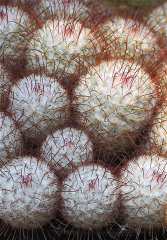Kerry Cossey hasn’t weeded her garden since the end of October, she never waters it and doesn’t use fertiliser. Her secret? Cacti.
Starting with one cactus on the windowsill of her bedroom when she was a child, Kerry later transferred her collection into troughs so it could move with her.
So when the chance came to work in Jan Gray’s cactus and succulent Archway Nurseries at Matapihi, Kerry jumped at the chance.
“Jan had terminal cancer so asked myself and Donna O’Toole to help out. We made up the name El Jakedo from the first part of our names – but, just two weeks later, Jan died and her husband offered the business to us. We really got thrown in at the deep end.”
That was in 2001 and, after moving the nursery to Donna’s property in Pyes Pa, it “came home” to the Welcome Bay hills in 2006 where Kerry now runs it on her own and has created a show garden for the nursery using cacti and succulents.
Palm trees provide a backdrop and the garden also includes interesting plants such as Xanthorrhoea australis (grass tree, native to Australia), Dracaena draco (Canary Islands dragon tree) which forms a bit more of its umbrella canopy each time it flowers, Euphorbia milii (crown of thorns) and the variegated Agave americana Painted Stripes.
“My grandmother and mother preferred succulents and grew lots of them, but I love the prickles,” Kerry says, “and both my sisters have cactus gardens in Waikato. Once you get them established, they’re adaptable plants and can withstand quite hard frosts.”
She has put weedmat on all her garden beds and covered them with stones and rocks which, as well as suiting the look of the plants, also help keep them warm in winter by trapping heat.
A handful of sheep pellets in the planting hole is the only fertiliser any of the plants receive.
“If you have good drainage, cacti will do well but, having said that, I have planted some in a clay bank. I dug a hole in the clay so it was like a pot, filled it with mix and then planted. The drainage metal on top helps hold the bank too.”
Cacti kept in pots do need to be watered over summer.
“Cacti should flower every year. If a plant has never flowered or stopped flowering repot it and put some sheep pellets in.”
Kerry wears dish-washing gloves when working with her cacti “so I know where the prickle is”. She immediately removes the barb, put some magnesium sulphate on a plaster and covers the wound.
Fine spines, that itch on contact with the skin, can be removed be putting Sellotape over the affected area and pulling it off quickly.
“But if you’re careful, you don’t get stung much,” she says. “I move or repot big plants by rolling up a sack, wrapping it round the plant and using it as a handle. You can do the same with a plastic bag for small ones.”
There are cacti that are more user-friendly, including Echinopsis (formerly Trichocereus) scopulicolus which starts out like any other cactus but loses its spines as the flesh of the plant grows over them, while little Mammillaria plumosa can be caressed due to its fluffy spines.
Kerry has peppered her garden with rusting farm implements pulled out of a dump on they found on the property – milk cans, a plough, old wheels. But the ultimate in recycling is alongside the drive. An old LandRover and trailer covered in plants.
El Jakedo Nursery and garden is open to visit by appointment, phone 544-1178 or 027 678 1034.
This article first appeared in the Bay of Plenty Times and appears here with permission. It has been edited slightly.



